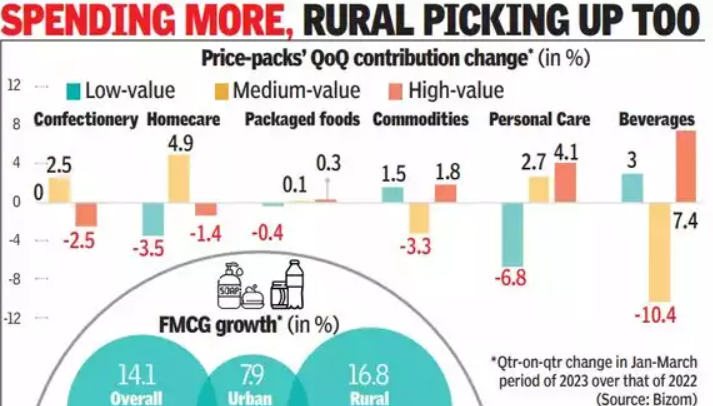Status of FMCG Industry in India
Syllabus:
- GS 3: Indian Economy
Why in the News?
Despite heavy rains that caused supply disruptions and disruption in some sectors like paint and beverages, strong rural demand could keep utilities businesses running smoothly at the second half of the financial year.
Introduction
- Consumer goods companies experienced steady growth in the September quarter, driven by strong rural demand that outpaced urban areas.
- But the heavy rains disrupted the supply chain and affected some categories like beverages.
- Despite these challenges, industries such as FMCG and jewellery are showing resilience, while paint and quick service restaurants are slowly gaining momentum
Status of FMCG industry in India
- Consumer goods companies are expected to report solid earnings in September 25 FY25 quarter.
- Rural markets outperformed urban markets through the quarter, fueling demand for basic commodities.
- Heavy rains and floods in parts of India have disrupted the supply chain and adversely affected consumers outside homes, especially in beverages
- Food and beverage companies may use higher commodity prices to cope with rising agricultural input costs.
- FMCG and jewellery companies are expected to maintain or even surpass their growth rate in Q2FY25.
- However, growth and profitability in industries such as fast-food restaurants, paint companies and breweries can be weak.
- The Beverages sector faced a slowdown due to seasonal weather and heavy rains, which affected its growth this quarter.
Moderate growth in near future
- Consumer goods companies are expected to post revenue growth of 5.7% in the September quarter of FY25.
- As compared to 9% in the same quarter last year in 2023, Volume growth could be around 5% in 2024.
- Analysts are forecasting low to moderate single-digit volume growth, continuing the trend of the previous quarter.
- Growth in several categories, including beverages and paints, has been weaker than initially expected after heavy rains disrupted business operations
- Increased competition in some segments has also contributed to slower growth.
- Rural demand is slowly improving, while urban demand is slowing slightly.
What is impacting the performance of FMCG Industry?
- Unprecedented rains adversely affected Outdoor paint, beverages, particularly affecting the overall performance of many companies.
- Quarterly results will be out later in October, which will give a clear picture of the impact on the sector.
- August report higlights, volume growth in the FMCG sector declined in June quarter, especially in food categories such as salt, flour and oil.
- Demand decline highlighted the challenges faced by FMCG companies, which are closely absorbing at market development and rural regeneration to plan future growth.
How significant is FMCG Industry for India?
- Economic Boom: FMCG industry is a major contributor to the Indian economic growth and development, which accounts for about 50% of consumer spending, thus contributing to economic growth.
- Job creation: FMCG industry creates millions of jobs at various levels from manufacturing to distribution. The sector employs many workers, improving livelihoods and contributing to poverty reduction.
- Management of Supply chain: The projects promote supply chain development, including farmers, manufacturers and retailers. It also promotes better logistics and distribution channels, increasing overall economic efficiency.
- Rural Empowerment: FMCG companies are backbone to rural job creation. They invest in farmers who source raw materials, provide good markets, and support local economies and improve standard of living.
- Innovation and Technology experimentation: The factory is known for its constant innovation and diversification in products. Companies often introduce new products to meet changing consumer preferences and taste, which encourages healthy competition.
- Revenue Generation for Government: it contributes significantly to the tax revenue of the government through various indirect taxes including GST. This revenue supports public services like health and education and infrastructure.
- Improving standard of living: Many FMCG companies offer products that focus on health and wellness and promote a healthy lifestyle example: Protinex milk powder, encouraging consumers to adopt healthier diets and lifestyles.
What challenges FMCG industry faces today?
- Climate Change: Unpredictable weather, such as heavy rains and flooding, disrupts supply chains and affects customer demand, limiting mobility, affecting access to resources.
- Rising investment costs: rising cost of inputs, especially agricultural inputs, is forcing companies to raise prices, which reduces consumer spending on necessities.
- Stiff Competition: Currently FMCG industry faces stiff competition, many Companies are struggling to differentiate their products, resulting in price wars that affect profitability.
- Changes in consumer preferences: quick adaptation to consumer preferences is needed to continue to move towards healthier and organic products like herbal hair oil,
- Inequality of Urban and Rural Demand: As Compared to rural areas, demand decreased in urban markets. Companies need to plan on how to increase sales in urban areas while maintaining rural growth.
- Supply chain challenges: Inadequate distribution in rural areas restrict market reach for FMCG products. Ensuring logistics efficiency is essential to broden reach to rural market.
- Legislative Amendments: Frequent policy changes by government, like GST pricing and food safety regulations, pose a challenge in terms of compliance. Adaptation becomes costly and time-consuming.
Conclusion
FMCG sector is gradually improving because of growth in rural consumption and expected increase in seasonal demand. Ongoing obstacles such as weather delays, smart pricing and government subsidies are also likely to open the door for robust growth in the coming months.
Source: Livemint
Mains Practice Question:
What are the challenges FMCG Industry facing in India due to climate change, How it is impacting the growth trajectory of FMCG Industry, what role government can play to encourage growth in FMCG industry?





